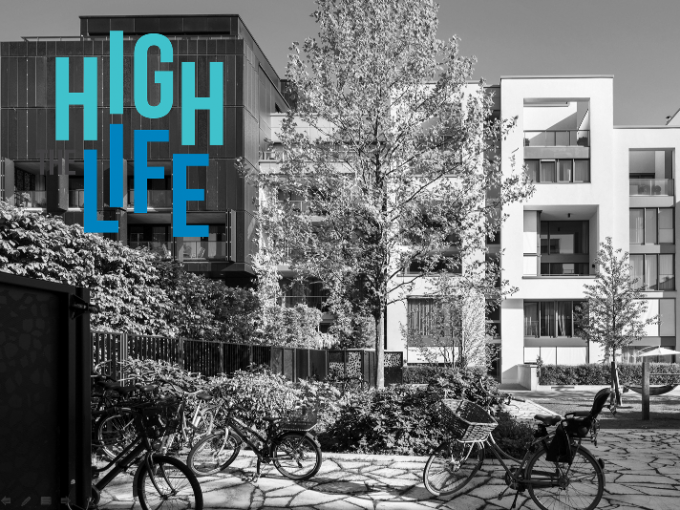The High Life project examines the interplay between apartment design policy, the design and location of apartment buildings, and residents’ health and wellbeing outcomes in Perth, Melbourne and Sydney.
The HIGH LIFE Study
Australia’s urban landscape has seen a shift towards apartment construction, with apartments now accounting for a third of all new residential building approvals in Australia. This construction boom has given rise to concerns about the quality, amenity and future versatility of apartment stock, with reports of micro apartments, windowless rooms and poor access to sunlight and air. Which raises the question – are apartment residents in Australia really living the high life?
Apartment design guidance differs across Australia in its detail, the specificity of requirements, and regulatory basis, with many states providing limited guidance. Could these policies influence the quality of the housing provided, and the health and wellbeing of residents? The HIGH LIFE Study has been set up to test whether specific apartment design features, and ‘the dose’ of these features, could impact residents’ health and wellbeing. It aims to provide the policy-specific health evidence needed to help create healthy higher density environments for future generations of apartment dwellers.
What did we do?
The HIGH LIFE Study collected information on apartments constructed in Perth, Melbourne and Sydney in the last 15 years. Apartments in these cities have been developed with different levels of policy guidance. Within each city, apartment residents in diverse neighbourhoods were surveyed, and objective measures of apartment design and wider neighbourhood characteristics (such as access to shops, services, transport and parks) were created. We generated measures for 113 apartment complexes, with over 1300 residents across these complexes responding to our survey.
What have we found?
We have prepared a report and infographic summarising key results from the study, which can be accessed via the links below:
HIGH LIFE Study summary report
Information on our publications and other research outputs can be found below. If you would like a copy of any of the papers listed, please contact the Study Coordinator, Dr Alexandra Kleeman (alexandra.kleeman@rmit.edu.au)
Foster, S., Hooper, P., Kleeman, A., & Turrell, G. (2024). Are All Apartments Equal? An Investigation of Contemporary Apartment Design Quality by Neighbourhood-Level Socioeconomic Disadvantage. Urban Policy and Research, 42(2), 124-138, doi: 10.1080/08111146.2024.2341883.
Foster, S., Kleeman, A., & Maitland, C. (2024). Research note: View from the top: Apartment residents’ views of nature and mental wellbeing during lockdown. Landscape and Urban Planning, 247 (105072), doi: 10.1016/j.landurbplan.2024.105072.
Bolleter, J., Hooper, P., Kleeman, A., Edwards, N., & Foster, S. (2024). A typological study of the provision and use of communal outdoor space in Australian apartment developments. Landscape and Urban Planning, 246 (105040), doi: 10.1016/j.landurbplan.2024.105040.
De Gruyter, C., Truong, L.T., de Jong, G., & Foster, S. (2024). Determinants of zero-car and car-owning apartment households. Transportation, doi: 10.1007/s11116-024-10467-8.
Kleeman, A., & Foster, S. (2023). Boxed in: changes in apartment residents’ health behaviours following the COVID-19 lockdown – a longitudinal cohort study. Cities & Health, 1-9, doi: 10.1080/23748834.2023.2294639.
Kleeman, A., Hooper, P., Edwards, N., Bolleter, J., & Foster, S. (2023). Research note: Associations between the implementation of communal open space design guidelines and residents’ use of these spaces in apartment developments. Landscape and Urban Planning, 230 (104613), doi: 10.1016/j.landurbplan.2022.104613.
Kleeman, A., & Foster, S. (2023). ‘It feels smaller now’: The impact of the COVID-19 lockdown on apartment residents and their living environment – A longitudinal study. Journal of Environmental Psychology, 89(102056), 1-9. doi:10.1016/j.jenvp.2023.102056.
Hooper, P., Kleeman, A., Edwards, N., Bolleter, J., Foster, S. (2023) The architecture of mental health: identifying the combination of apartment building design requirements for positive mental health outcomes. The Lancet Regional Health – Western Pacific, 37(100807), doi:10.1016/j.lanwpc.2023.100807.
Foster, S., Hooper, P., Turrell, G., Maitland, C., Giles-Corti, B., & Kleeman, A. (2023). Grand designs for design policy: Associations between apartment policy standards, perceptions of good design and mental wellbeing. SSM Population Health, 20(101301), doi:10.1016/j.ssmph.2022.101301.
De Gruyter, C., Hooper, P., Foster, S. (2023). Do apartment residents have enough car parking? An empirical assessment of car parking adequacy in Australian cities. Journal of Transport Geography, 107(103542), doi: 10.1016/j.jtrangeo.2023.103542.
Kleeman, A., Giles-Corti, B., Gunn, L., Hooper, P., & Foster, S. (2023). The impact of the design and quality of communal area in apartment buildings on residents’ neighbouring and loneliness. Cities, 133(104126), doi: 10.1016/j.cities.2022.104126.
Foster, S., Hooper, P., Duckworth, A., Bolleter, J. (2022). An evaluation of the policy and practice of designing and implementing healthy apartment design standards in three Australian cities. Building and Environment, 207 (108493), doi:10.1016/j.buildenv.2021.108493.
Hooper, P., Bolleter, J., Edwards, N., Kleeman, A., Duckworth, A., & Foster, S. (2022). Measuring the high life: A method for assessing apartment design policy implementation. MethodsX, 9, 101810, doi:10.1016/j.mex.2022.101810.
Kleeman, A., Hooper, P., Giles-Corti, B., & Foster, S. (2022). A new Australian dream? Exploring associations between apartment design attributes and housing satisfaction in three Australian cities. Cities, 131 (104043), doi:10.1016/j.cities.2022.104043.
Foster, S., Hooper, P., & Easthope, H. (2022). Cracking up? Associations between building defects and mental health in new Australian apartment buildings. Cities & Health, doi:10.1080/23748834.2022.2048946.
Kleeman, A., Giles-Corti, B., Gunn, L., Hooper, P., & Foster, S. (2022). Exploring the design, quality and use of communal areas in apartment developments. Cities & Health, 6(3), 480-494, doi:10.1080/23748834.2021.2001169.
Kleeman, A., Gunn, L., Giles-Corti, B., & Foster, S. (2022). Communal area design in apartment buildings: development and comparison of a desktop and on-the-ground landscape assessment tool. Cities & Health, 6(3), 635-649, doi:10.1080/23748834.2020.1773034.
Foster, S., Hooper, P., Kleeman, A., Martino, E., & Giles-Corti, B. (2020). The high life: A policy audit of apartment design guidelines and their potential to promote residents’ health and wellbeing. Cities, 96, 102420, doi:10.1016/j.cities.2019.102420.
Foster, S., Maitland, C., Hooper, P., Bolleter, J., Duckworth-Smith, A., Giles-Corti, B., & Arundel, J. (2019). High Life Study protocol: a cross-sectional investigation of the influence of apartment building design policy on resident health and well-being. BMJ Open, 9 (e029220), doi:10.1136/bmjopen-2019-029220.
Follow-up studies
The HIGH LIFE – PARK LIFE Study
Our team was awarded an Australian Research Council (ARC) Discovery grant (DP210103736) to investigate how apartment dwellers use public open space, including which public open space residents use, and for what purposes. The project aims to create tailored, evidence-based recommendations for equitable public open space planning to better support apartment residents’ needs. For more information on the HIGH LIFE-PARK LIFE study, please contact the study co-ordinator, Dr Alex Kleeman
‘Movers and Stayers’ Study
Does the design of your apartment and local neighbourhood influence your decisions to stay or move? In early 2024, we reached out to residents who completed the original HIGH LIFE survey to invite them to complete a short survey about whether they still live in the same apartment or have moved to a new place and why. Analyses are currently underway. Findings will be released early in 2025.
COVID-19 survey
The COVID-19 pandemic restrictions have been unprecedented, and we wondered how people living in apartments were managing during this challenging period. We contacted High Life participants to learn more about their experience of apartment living during lockdown. Our analyses highlighted a complex interplay of personal, social and environmental impacts of the pandemic on residents. More details on our results can be found in the publications / research outputs section above.
Project funders and partners
The HIGH LIFE Study is funded by the Western Australian Health Promotion Foundation (Healthway) (#31986) and the Australian Research Council (DE160100140 & FT210100899). We have ethics approval from RMIT University (21146 & 25922).
We acknowledge Dr Paula Hooper for her development of the policy-derived building measures, and Dr Clover Maitland, Dr Paula Hooper and Professor Billie Giles-Corti for their assistance in the development of the survey.
High Life Study e-news – September 2023 Update
You can view our latest project update, featuring study news, events and results, here.
If you would like to subscribe to the High Life Study e-news please click on this link..




